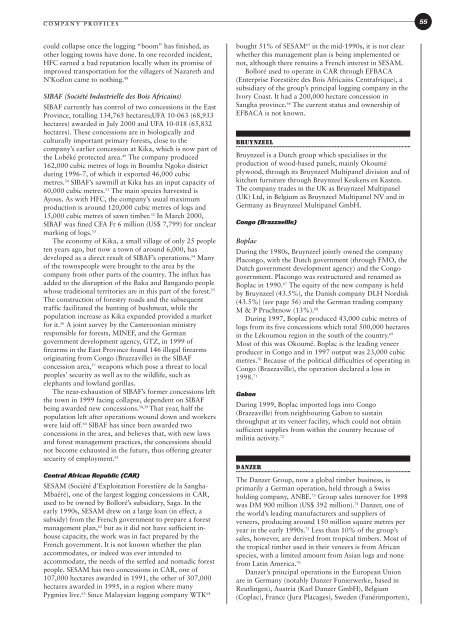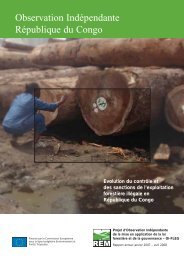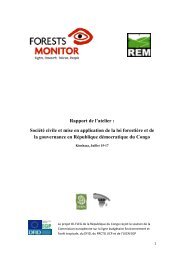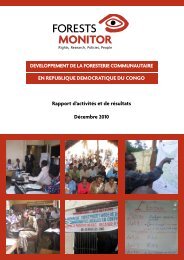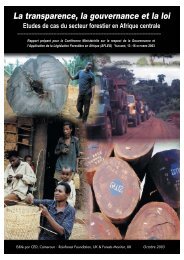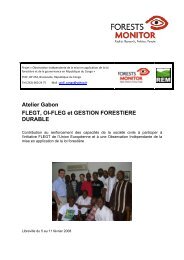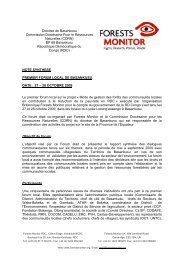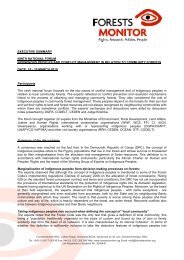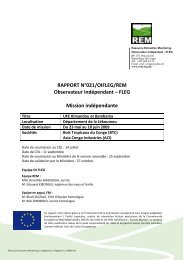Sold down the river - Salva le Foreste
Sold down the river - Salva le Foreste
Sold down the river - Salva le Foreste
Create successful ePaper yourself
Turn your PDF publications into a flip-book with our unique Google optimized e-Paper software.
COMPANY PROFILES 55could collapse once <strong>the</strong> logging “boom” has finished, aso<strong>the</strong>r logging towns have done. In one recorded incident,HFC earned a bad reputation locally when its promise ofimproved transportation for <strong>the</strong> villagers of Nazareth andN’Koélon came to nothing. 48SIBAF (Société Industriel<strong>le</strong> des Bois Africains)SIBAF currently has control of two concessions in <strong>the</strong> EastProvince, totalling 134,765 hectares;UFA 10-063 (68,933hectares) awarded in July 2000 and UFA 10-018 (65,832hectares). These concessions are in biologically andculturally important primary forests, close to <strong>the</strong>company’s earlier concession at Kika, which is now part of<strong>the</strong> Lobéké protected area. 49 The company produced162,000 cubic metres of logs in Boumba Ngoko districtduring 1996-7, of which it exported 46,000 cubicmetres. 50 SIBAF’s sawmill at Kika has an input capacity of60,000 cubic metres. 51 The main species harvested isAyous. As with HFC, <strong>the</strong> company’s usual maximumproduction is around 120,000 cubic metres of logs and15,000 cubic metres of sawn timber. 52 In March 2000,SIBAF was fined CFA Fr 6 million (US$ 7,799) for unc<strong>le</strong>armarking of logs. 53The economy of Kika, a small village of only 25 peop<strong>le</strong>ten years ago, but now a town of around 6,000, hasdeveloped as a direct result of SIBAF’s operations. 54 Manyof <strong>the</strong> townspeop<strong>le</strong> were brought to <strong>the</strong> area by <strong>the</strong>company from o<strong>the</strong>r parts of <strong>the</strong> country. The influx hasadded to <strong>the</strong> disruption of <strong>the</strong> Baka and Bangando peop<strong>le</strong>whose traditional territories are in this part of <strong>the</strong> forest. 55The construction of forestry roads and <strong>the</strong> subsequenttraffic facilitated <strong>the</strong> hunting of bushmeat, whi<strong>le</strong> <strong>the</strong>population increase as Kika expanded provided a marketfor it. 56 A joint survey by <strong>the</strong> Cameroonian ministryresponsib<strong>le</strong> for forests, MINEF, and <strong>the</strong> Germangovernment development agency, GTZ, in 1999 offirearms in <strong>the</strong> East Province found 146 il<strong>le</strong>gal firearmsoriginating from Congo (Brazzavil<strong>le</strong>) in <strong>the</strong> SIBAFconcession area, 57 weapons which pose a threat to localpeop<strong>le</strong>s’ security as well as to <strong>the</strong> wildlife, such ase<strong>le</strong>phants and lowland gorillas.The near-exhaustion of SIBAF’s former concessions <strong>le</strong>ft<strong>the</strong> town in 1999 facing collapse, dependent on SIBAFbeing awarded new concessions. 58,59 That year, half <strong>the</strong>population <strong>le</strong>ft after operations wound <strong>down</strong> and workerswere laid off. 60 SIBAF has since been awarded twoconcessions in <strong>the</strong> area, and believes that, with new lawsand forest management practices, <strong>the</strong> concessions shouldnot become exhausted in <strong>the</strong> future, thus offering greatersecurity of employment. 61Central African Republic (CAR)SESAM (Société d’Exploitation Forestière de la Sangha-Mbaéré), one of <strong>the</strong> largest logging concessions in CAR,used to be owned by Bolloré’s subsidiary, Saga. In <strong>the</strong>early 1990s, SESAM drew on a large loan (in effect, asubsidy) from <strong>the</strong> French government to prepare a forestmanagement plan, 62 but as it did not have sufficient inhousecapacity, <strong>the</strong> work was in fact prepared by <strong>the</strong>French government. It is not known whe<strong>the</strong>r <strong>the</strong> planaccommodates, or indeed was ever intended toaccommodate, <strong>the</strong> needs of <strong>the</strong> sett<strong>le</strong>d and nomadic forestpeop<strong>le</strong>. SESAM has two concessions in CAR, one of107,000 hectares awarded in 1991, <strong>the</strong> o<strong>the</strong>r of 307,000hectares awarded in 1995, in a region where manyPygmies live. 63 Since Malaysian logging company WTK 64bought 51% of SESAM 65 in <strong>the</strong> mid-1990s, it is not c<strong>le</strong>arwhe<strong>the</strong>r this management plan is being imp<strong>le</strong>mented ornot, although <strong>the</strong>re remains a French interest in SESAM.Bolloré used to operate in CAR through EFBACA(Enterprise Forestière des Bois Africains Centrafrique), asubsidiary of <strong>the</strong> group’s principal logging company in <strong>the</strong>Ivory Coast. It had a 200,000 hectare concession inSangha province. 66 The current status and ownership ofEFBACA is not known.BRUYNZEELBruynzeel is a Dutch group which specialises in <strong>the</strong>production of wood-based panels, mainly Okouméplywood, through its Bruynzeel Multipanel division and ofkitchen furniture through Bruynzeel Keukens en Kasten.The company trades in <strong>the</strong> UK as Bruynzeel Multipanel(UK) Ltd, in Belgium as Bruynzeel Multipanel NV and inGermany as Bruynzeel Multipanel GmbH.Congo (Brazzavil<strong>le</strong>)BoplacDuring <strong>the</strong> 1980s, Bruynzeel jointly owned <strong>the</strong> companyPlacongo, with <strong>the</strong> Dutch government (through FMO, <strong>the</strong>Dutch government development agency) and <strong>the</strong> Congogovernment. Placongo was restructured and renamed asBoplac in 1990. 67 The equity of <strong>the</strong> new company is heldby Bruynzeel (43.5%), <strong>the</strong> Danish company DLH Nordisk(43.5%) (see page 56) and <strong>the</strong> German trading companyM & P Pruchtnow (13%). 68During 1997, Boplac produced 43,000 cubic metres oflogs from its five concessions which total 500,000 hectaresin <strong>the</strong> Lékoumou region in <strong>the</strong> south of <strong>the</strong> country. 69Most of this was Okoumé. Boplac is <strong>the</strong> <strong>le</strong>ading veneerproducer in Congo and in 1997 output was 23,000 cubicmetres. 70 Because of <strong>the</strong> political difficulties of operating inCongo (Brazzavil<strong>le</strong>), <strong>the</strong> operation declared a loss in1998. 71GabonDuring 1999, Boplac imported logs into Congo(Brazzavil<strong>le</strong>) from neighbouring Gabon to sustainthroughput at its veneer facility, which could not obtainsufficient supplies from within <strong>the</strong> country because ofmilitia activity. 72DANZERThe Danzer Group, now a global timber business, isprimarily a German operation, held through a Swissholding company, ANBE. 73 Group sa<strong>le</strong>s turnover for 1998was DM 900 million (US$ 392 million). 74 Danzer, one of<strong>the</strong> world’s <strong>le</strong>ading manufacturers and suppliers ofveneers, producing around 150 million square metres peryear in <strong>the</strong> early 1990s. 75 Less than 10% of <strong>the</strong> group’ssa<strong>le</strong>s, however, are derived from tropical timbers. Most of<strong>the</strong> tropical timber used in <strong>the</strong>ir veneers is from Africanspecies, with a limited amount from Asian logs and nonefrom Latin America. 76Danzer’s principal operations in <strong>the</strong> European Unionare in Germany (notably Danzer Funierwerke, based inReutlingen), Austria (Karl Danzer GmbH), Belgium(Coplac), France (Jura Placages), Sweden (Fanérimporten),


